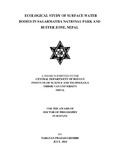Please use this identifier to cite or link to this item:
http://archive.nnl.gov.np:8080/handle/123456789/281| Title: | Ecological study of surface water bodies in Sagarmatha National Park and Buffer zone, Nepal |
| Authors: | Ghimire, Narayan Prasad |
| Keywords: | Sagarmatha National Park Buffer zone -- Nepal |
| Issue Date: | 22-Feb-2018 |
| Abstract: | Sagarmatha National Park (SNP), located in southern slope of Sagarmatha (Mt. Everest) in eastern Nepal is a popular international eco-touristic destination. The Park provides a unique opportunity to study and observe diverse flora, fauna, environment and socio-culture, at the same time facing the problem of environmental degradation because of increased tourism. In the last few years, water quality in the SNP has been found degraded because of enhanced flow of tourists and their activities. To assess the quality of water bodies, physical, chemical, microbiological, algal and aquatic microinvertebrate analyses were done during 2008-2011. Changes in pH, increase of total nitrogen as nitrate (TN-NO3), total phosphorous as phosphate (TP-PO4) were noted in the waterbodies in SNPBZ. Total nitrogen in water samples was lower than the WHO standard but an increase in the nitrate-nitrogen has been recorded when compared with the earlier reports. Similarly total phosphorous value was found increased. Iron (Fe) concentration also increased when compared with earlier report. Iron (Fe) content in eighteen samples has been found more than WHO and Nepalese standards for drinking water. The trend in metal content in waterbodies in Sagarmatha National Park and Buffer Zone was in the following order: Pb>Cu>Zn >Mn>Mg>Fe>Na. Sodium (Na), Magnesium (Mg), Lead (Pb), Manganese (Mn), Copper (Cu) and Zinc (Zn) were found within the limit set for drinking purpose. Results reveal that quantity of these heavy metals has increased in the last few years. During the present investigation, a total 59 species of algae have been reported from Sagarmatha National Park and Buffer Zone, Nepal. Among them Chlorophyceae, Bacillariophyceae, Cyanophyceae were the most dominating families. One species belonging to family Xanthophyceae is also enumerated from this region. Gokyo lake (1st and 3rd) located at more than 4600m altitude had more algal species than other Gokyo lakes. Generally unicellular, colonial algae and desmids were found to be dominant in stagnant water where as filamentous green algae were common in both running and stagnant waterbodies. Six species (Euastrum oblongum, Penium cylindrus, Spirogyra amplectens, Euastrum coralloides, Cymbella lanceolata and Oscillatoria insignis) were found new record for Nepal. Five orders of micro-invertebrate (Ephemeroptera, Plecoptera, Tricoptera, Trichedida and Diptera) belonging to fourteen families (Baetidae, Heptageniidae, Ameltidae, Nemouriidae, Capniidae, Perlidae, Leuctridae, Leptoceridae, Rhyacophilidae, Glossosomatidae, Planariidae, Chironomidae, Simulidae and Tripulidae) were recorded during the present study in different waterbodies (lakes, springs and rivers) of the SNPBZ. Baetidae family was found as the dominant family in SNPBZ region. Contamination of feacal coliform in most waterbodies in the SNPBZ area was low. Escherichia coli and Streptococcus faecolies bacteria were recorded in 13 % of water samples collected from SNPBZ which could be due to the activities of visitors and increase in human waste especially human excreta. Many of the toilets in SNPBZ are not maintained, completely full and have effluent leaking to nearby water bodies. The best part of the agriculture here is its organic form. Average rate of use of organic fertilizer is 8 t/ha, that is more than the recommended dose. At this rate, the nitrogen, phosphorous and potassium to the agricultural field comes around 97, 54.4 and 136.8 kg/ha. To meet the high demand of potato in hotels and tea shops people might have used organic fertilizer at the rate higher than recommended dose for potato crop to maximize the yield. Non-scientific management of solid waste (no separation of waste and construction of collection pit near water course); open defecation and poor condition of septic tanks; and direct disposal of toilet waste to water courses or on the exposed surface, are major sources of surface water pollution. Some sites along the trekking routes showed faecal contamination. The surface water quality in general still stands good in terms of standard for drinking water (WHO, Nepal standard) but degradation process has started. High solid waste generation due to high tourism flow, no proper management practice of solid waste, open defecation, construction of garbage pit near the water coarse were found the root causes for water pollution. |
| Description: | A thesis submitted to the Central Department of Botany, Institute of Science and Technology, Tribhuvan University, Nepal for the award of Doctor of Philosophy in Botany, 2014. |
| URI: | http://103.69.125.248:8080/xmlui/handle/123456789/281 |
| Appears in Collections: | 500 Natural sciences and mathematics |
Files in This Item:
| File | Description | Size | Format | |
|---|---|---|---|---|
| 6. Dr.Narayan P. Ghimire.pdf | 7.36 MB | Adobe PDF |  View/Open |
Items in DSpace are protected by copyright, with all rights reserved, unless otherwise indicated.